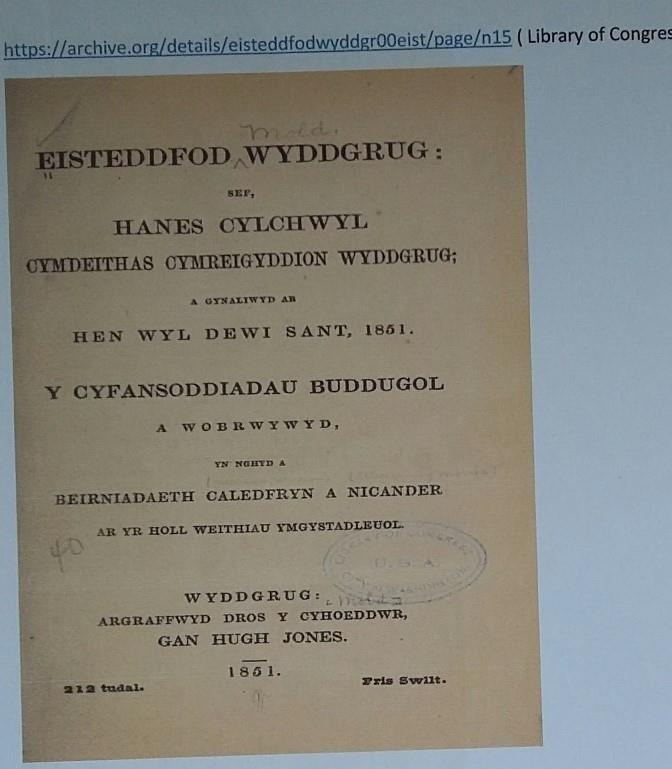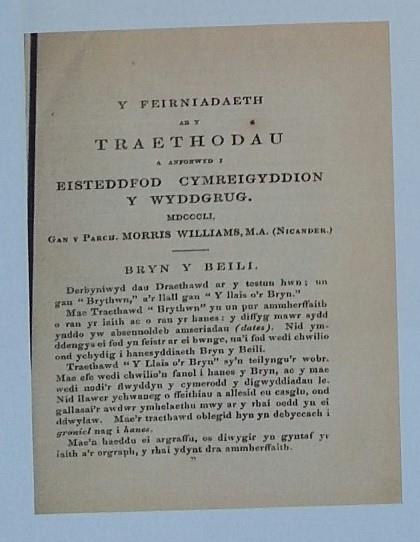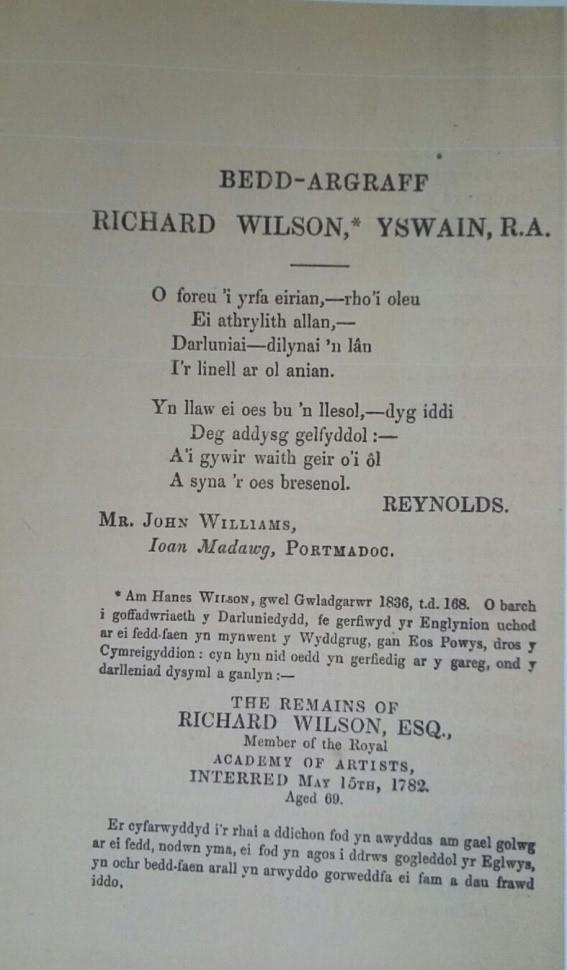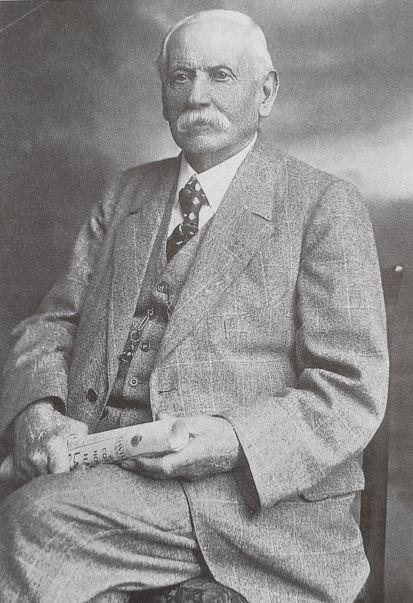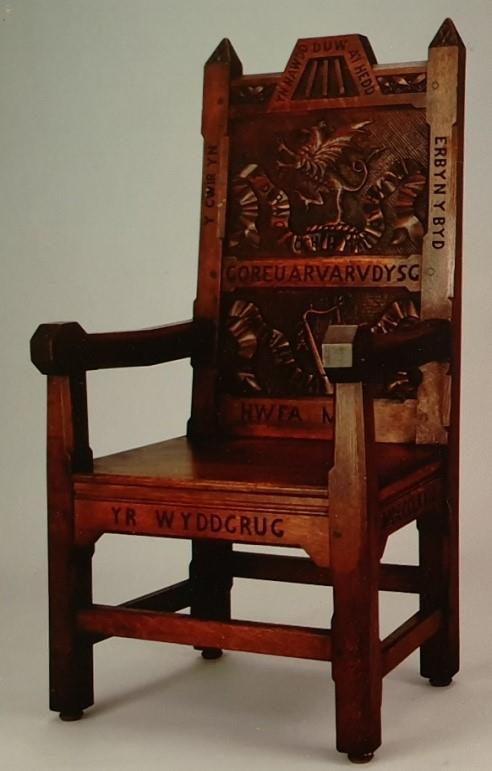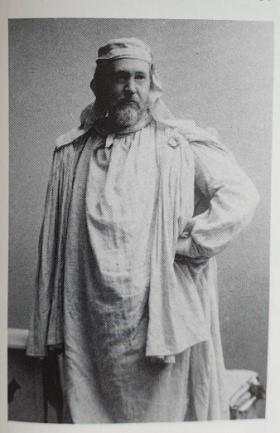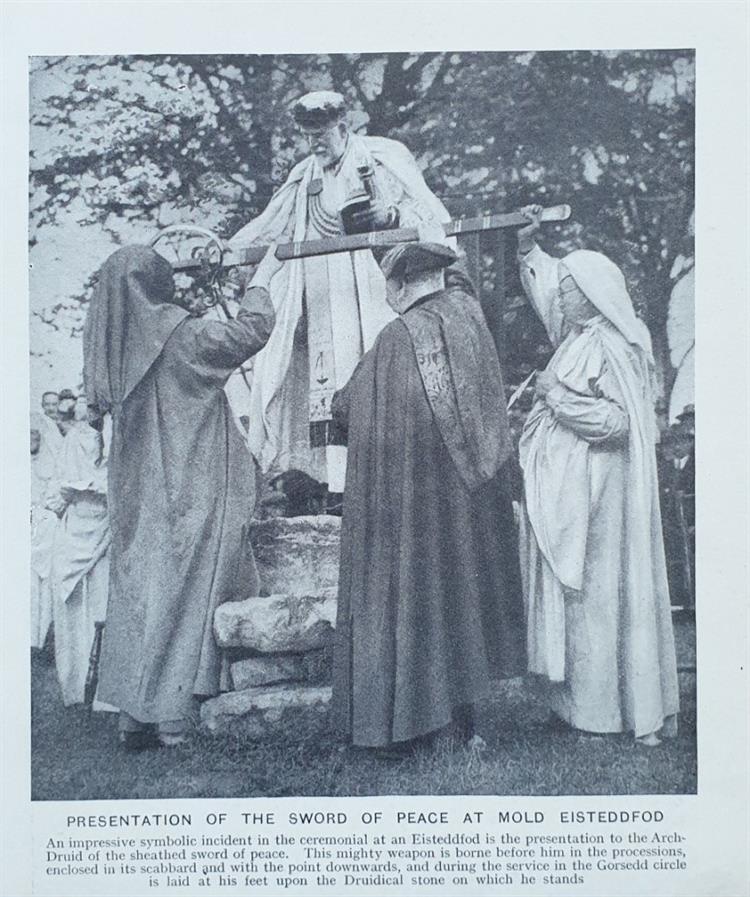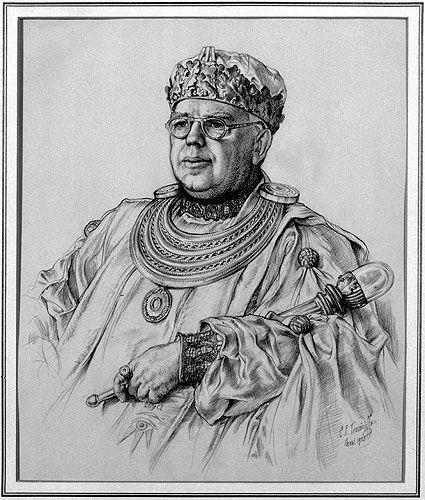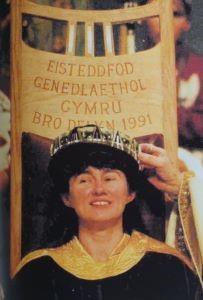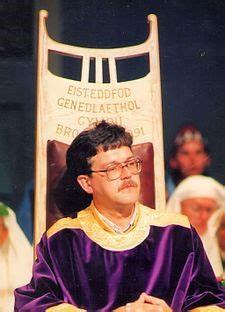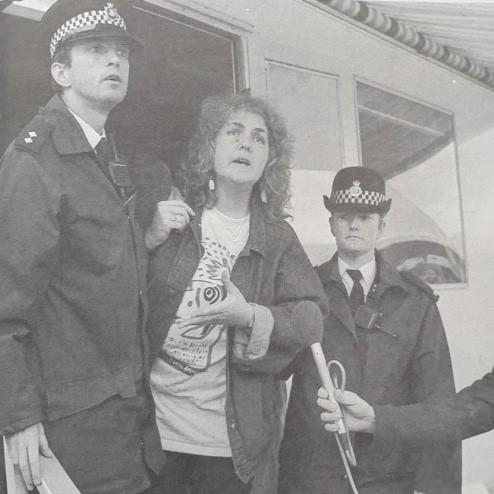The Gorsedd Stones of Bailey Hill
Inspiring Welsh culture
In 1922, the Gorsedd stones were erected in readiness for the 1923 National Eisteddfod in Mold, as structures to commemorate the coming of the eisteddfod and as a central point for the ceremonies of the Gorsedd. At the time, the building of the stones on an ancient monument was controversial but the stones soon became accepted as an integral part of the Bailey Hill park.
The winner of the prestigious competition for the Crown in the 1923 was Cynan. Rev. Albert Evans-Jones (Cynan)’s winning poem at the Mold National Eisteddfod of 1923 was entitled ‘Yr Ynys Unig’ [translation – ‘The Lonely isle’]. It related the story of Father Damien’s mission to the lepers, in Hawaii [Source: Dictionary of Welsh Bilgraphy]. The Belgian priest (1871-1889) – who inspired Cynan’s winning ode – was later canonized by Pope Benedict XVI on 11 October 2009. [Source: Wikipedia].
Cynan became a very influential figure in Welsh bardic history. Cynan would go on to design the National Eisteddfod Crowning and Chairing ceremonies that we still use today. The format was designed to reflect the cultural interests of the Welsh.
Some 100 years earlier, in the 1823 local Mold eisteddfod, the Chair was won by John Blackwell (Alun) for his lyrical poem in Welsh (“Someone”) which includes the lines: “While there’s a cliff in Snowdonia, while there are trees atop the Bailey, while there is water in the river Alun, I’ll keep a pure heart for Someone”.
Alun’s winning poeam at the Mold 1832 Eisteddfod related the traditional story about a mjor battle at Meas Garmon, Rhual – just half a mile north of Bailey Hill, where legend has it that the Welsh defeated Pict and Saxon forces from the east, c.429AD.
The 1851 local eisteddfod organised by the Welsh Society of Mold (the ‘Cymmrodorion), produced the winning essay by James Hughes Jones on the theme of the history of Bailey Hill. Several poems submitted to that Eisteddfod also referred to Bailey Hill. Another of its poetry competitions was won by Ioan Madawg, and two verses of his composition were inscribed on the famous landscape painter Richard Wilson’s gravestone, behind St Mary’s Church, Mold.
Bailey Hill’s Gorsedd circle continues to be a green space for inspiration and contemplation.
Link to a Gorsedd Ceremony on Youtube:
The first documented record of people “sitting together” in a musical festival comes from the medieval Courts of Wales in the early 12th century, although in reality, a less formal version of this type of entertainment would probably have already been in existence before that time.
The courts of the Princes of Wales of the early 1100s were entertained by poets and musicians, who wrote and sang praise poetry. Early written Welsh literature includes The Chronicle of the Welsh Princes (Brut y Tywysogion). It tells the story of the famous battle of 1146, at the castle called ‘Wydgruc’ (“nebun gastell a elwit Wydgruc) when the Welsh prince, Owain Gwynedd, was successful in taking Mold Castle from the Norman army in a fierce battle.
Owain Gwynedd (c1100/23 to 1170) was a great patron of Welsh poetry and one of his sons, Hywel ap Owain Gwynedd, was considered a great poet. Hywel’s poem of the early C12th praises the natural beauty of his father’s kingdom of Gwynedd, and the beauty of Welsh women. Some scholars detect the influence of French court poetry on his work. This poem was acclaimed in its own time and it can be found today in The Oxford Book of Welsh Verse.
Cynddelw Brydydd Mawr was probably the best known poet of his day in the mid to late 12th century. He composed poems in praise of the royal courts of Wales well into the 13th century. Cynddelw would compose and sing his praise poetry in the courts of three different rulers: Madog Maredydd, Prince of Powys; then Owain Gwynedd, Prince of Gwynedd; and lastly Lord Rhys of Deheubarth. Cynddelw’s work consisted of traditional love poetry, eulogies and elegies and he would write his poems in the strict metre of the englyn and the awdl (ode).
After the death of Owain Gwynedd, in 1170, the Lord Rhys (Yr Arglwydd Rhys) became the main figure in Wales opposing the Normans and striving to keep Wales Welsh. Ironically, the Welsh-language encyclopaedia Y Gwyddoniadur suggests that Lord Rhys’s decision to hold the very first Eisteddfod in Cardigan Castle in 1176, may have been influenced to some extent by the Norman tradition of competitive bardic competitions (called puy). Lord Rhys’s eisteddfod offered the coveted prizes of Y Gadair (the Chair) and Y Goron (the Crown), and the country’s best poets and musicians competed for these accolades.
The eisteddfod today is a greatly expanded version of the early “sitting together”. It is a competitive cultural event of poetry, literature, music, performance, art and more. But the chief prizes in a modern national eisteddfod continue to be the Chair and the Crown, and poems continue to be set to music.
The roots of the modern-day eisteddfod and the Gorsedd were being planted in the late 1700s at around the same time as Bailey Hill was being planted with trees under the ownership of the Swymmer-Champneys. (embed link to the history timeline) In the late 18th century, the London Welsh population formed the Gwyneddigion Society of London, the name Gwyneddigion being derived from the north Wales heartland - “people of Gwynedd”. Out of the Gwyneddigion Society came Iolo Morganwg, a poet and political radical, who established a society of poets, writers, musicians and artists which he called Gorsedd Beirdd Ynys Prydain (The Gorsedd of the Bards of the Island of Britain).
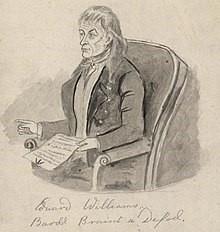
But, in 1792, the world was not ready for Iolo, and this was when the Gorsedd held its first meeting in Primrose Hill, London on Midsummer’s day, June 21. Here, Iolo’s ceremonies and symbols were aired in public for the first time. His insistence on claiming that these were ancient ceremonies and symbols was ill-advised as it opened the door to casual disparagement.
Nevertheless, Iolo’s notions resonated strongly with Welsh sensibilities and the Gorsedd movement has succeeded in embedding its symbols and ceremonies into Welsh cultural identity:the stone circle, the Gorsedd Prayer, the druids, the robes, the Corn Hirlas, the Gorsedd Banner and more.Iolo Morganwg’s vision has endured. It’s still not quite ancient, but now well over 200 years old.
Gweddi’r Orsedd (The Gorsedd Prayer)
One of the most moving moments in ceremonies of the Gorsedd is the Gorsedd Prayer.
This is the simple but effective format
- The soloist sings the first line, followed by the eisteddfod audience singing the same words, but singing only on one note, taking that note from the last one sung by the soloist.
- The soloist then sings the second line and the process is repeated until the last line, where all sing together.
- A Welsh eisteddfod audience can be relied upon to form an impromptu choir and to make a wonderful sound, and if the occasion demands, in four-part harmony.
Gweddi’r Orsedd (The Gorsedd Prayer)
Dyro Dduw, dy nawdd
Ac yn nawdd, nerth
Ac yn nerth, deall
Ac yn neall, gwybod
As yng ngwybod, gwybod y cyfiawn,
Ac yng ngwybod y cyfiawn, ei garu
Ac o garu, caru pob hanfod
Ac ym mhob hanfod, caru Duw
Duw a phob daioni
The musical event in Corwen, North Wales, in 1789 is considered the very first modern eisteddfod. This well-organised event had its competitions announced in advance, with programmes printed, medals awarded and with adjudications of the competitions published after the event. Despite or perhaps because of this level of organisation, the eisteddfod nevertheless went out of fashion for a while.
The catalyst for its reinvention was when Iolo Morganwg (Edward Williams) linked up the Gorsedd of the Bards with those local people who wanted to hold an eisteddfod. The Camarthen 1819 eisteddfod was the first such example and a landmark in eisteddfod history. This combination of Gorsedd and eisteddfod organisation paved the way for the eisteddfod to become a much more enduring and powerful vehicle for the cultural identity of the people of Wales.
The Denbigh eisteddfod of 1860 saw the establishment of an elected council of members who formed an executive committee to run the eisteddfod. The foundations were therefore laid for the first official national eisteddfod at Aberdare in 1861.
The organisers of the Mold eisteddfod of 1873 also called it a national eisteddfod although this was an unofficial designation. It lived up to its billing by attracting support from the Prime Minister, William Ewart Gladstone, whose country home was Hawarden Castle in Flintshire. This added prestige helped the eisteddfod organisers to attract the best of Wales’s poets and writers to compete in Mold, and to celebrate their successes on Bailey Hill.
From the mid-19th century to the mid-20th century, the eisteddfod was a mixture of both Welsh and English language in terms of ceremonies and competitions but English was, if anything, the dominant language. The wealthy Welsh gentry who were patrons and funders of the eisteddfod had also become anglicized and predominantly English-speaking, therefore the eisteddfod had to reflect this pre-eminence in its proceedings. This led to the erosion of the Welsh language’s hold as the main language to be used within the National Eisteddfod during this time.
Re-establishing Welsh as the language of the National Eisteddfod
In 1950, Cynan (Albert Evans Jones) as Archdderwydd (Archdruid) established “the Welsh principle”, which made Welsh the only language of official ceremony and competition at the national eisteddfod. Cynan, of course, was a highly respected bard who had won the Crown as a young man at the Mold eisteddfod in 1923. The notable chaired bard, Alan Llwyd, claims that Cynan and not Hedd Wyn, is the premier Welsh war poet of the First World War, as Cynan drew upon on his personal experience of war.
Cynan became a very influential person in Welsh life as a result of his modernising agenda for the National Eisteddfod:
- In 1936, with help from schoolteachers in Machynlleth, he designed the Floral Dance which is part of the Gorsedd ceremonies
- In 1937 a very significant achievement was to persuade the Gorsedd and the eisteddfod Council to form one national body, the Court of the Eisteddfod, with both parties of equal status leading to greater effectiveness in running the National Eisteddfod
- He redesigned the major ceremonies – the proclamation, the chairing, the crowning – into dramatic and colourful events
- He was also the first Archdruid to publicly pronounce that the Gorsedd was Iolo Morganwg’s 19th century invention and the symbols and ceremonies were not based on ancient druidic tradition (embed link to the Gorsedd page)
- Cynan held the role of Archdruid twice as well as other official roles within the Gorsedd.
A postscript to this account is that in 2019, the Archdruid (Archdderwydd) Myrdddin ap Dafydd announced that henceforth the Gorsedd of the Bards (Gorsedd y Beirdd) would become known as Gorsedd Cymru, to remove the emphasis on bards, and to reflect the more modern cultural life of Wales. Like Cynan in the 20th century, Myrddin ap Dafydd in the early 21st century is modernising the eisteddfod movement and the Gorsedd. (embed link to the Modern day Eisteddfod)
There is more than one type of eisteddfod:
- the Eisteddfod Cerdd Dant focuses on a particular type of singing, with verses/poetry set to a range of musical airs, accompanied by the harp.
- There is an eisteddfod that is exclusively for young people, Eisteddfod yr Urdd Gobaith Cymru.
- There are small eisteddfodau in Welsh towns and villages
- There are school eisteddfodau throughout Wales
- All of these events provide the opportunity to practice poetic, musical, dramatic and artistic skills in a variety of competitions, at whatever level is appropriate for the individual. Many well-known performers who entered competitions at eisteddfodau say that the experience of performing in front of an audience and adjudicators is an invaluable experience in their personal development.
- Separate to the National Eisteddfod is the independently run Llangollen International Musical Eisteddfod. It has been held every year since 1947 and allows people of all nations to celebrate their music and their choirs in their own languages, as well as their own folk dancing and national costumes.
Several forces come together to produce what we now recognise as the eisteddfod of today.
- Firstly, there is the group of poets, writers, musicians collectively known as the Gorsedd y Beirdd (Gorsedd of the Bards).
- Secondly, there is another group without whom the eisteddfod could not run - the members of the Eisteddfod Council.
- The above two groups come together to form the Eisteddfod Court (Llys)
- Thirdly, there is the all-important Pwyllgor Gwaith (Organising Committee) who make the event successful by organising the venue, the schedules, the competitors, the visitors, the trade stands, the refreshments, the policing etc.
- Fourthly, there is a multitude of small local and school eisteddfodau that provide the breeding ground for young talent around Wales. These young performers, writers, musicians, dancers and artists can progress through the eisteddfod system to successively higher, more competitive levels. The most talented go on to achieve national and international success.
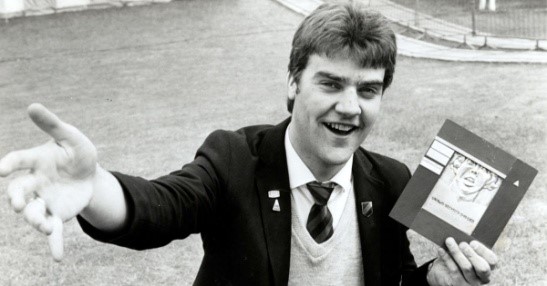
The young Bryn Terfel is shown here (Daily post terfel01.jpg (1200×630) (dailypost.co.uk)) in his school uniform, having just been successful in a Solo Singing Competition (15-19 years of age) at an eisteddfod. He progressed through the eisteddfod system, winning the Ysgoloriaeth W Towyn Roberts (the Scholarship Prize for the most promising young singer) at the National Eisteddfod of 1987. He is now, of course, established at the very top level of opera, one of the best bass-baritones in the world.
What actually happens at the National Eisteddfod?
The Eisteddfod Genedlaethol (the National Eisteddfod) takes place in the first full week in August, and alternates from one year to the next between north and south Wales. Local land owners invite the eisteddfod committee to use their land, and a vast operation is set up. The main attractions are in the Maes (the Field) but other areas are also established such as “Maes B” for young people and contemporary music acts. There are many pavilions, competitions and performances showcasing music, poetry, drama, literature, science and fine art.
The main pavilion is where the musical and performing arts competitions and main ceremonies now take place, but the Maes has a multitude of other offerings: Y Babell Len (Literature Area); Ty Gwerin (the contemporary and traditional folk music stage); an open-air concert stage; the Science area; the Maes D (the Welsh learners area ); and Lle Celf (the Art Space).
Out on the Maes, there is a plethora of stalls selling books, music and Welsh goods. There are also trade stands with representatives from Welsh organisations, charitable organisations, educational establishments, societies and councils, and finally the all-important tea, coffee and ice-cream kiosks, restaurants and bars.
In the National Eisteddfod, there is a strict language rule that makes Welsh the official language of all the proceedings, competitions and activities. Of course, it is not the only major cultural institution in the UK with a language rule. For example, English National Opera also has a strict rule that all the opera it performs is sung in English to enhance ‘the emotional connection between performers and audiences’ (see ENO website). This “Welsh language principle” puts the use of the Welsh language at the core of the Eisteddfod.
However, this is a cultural festival that also welcomes non-Welsh-speakers, many of whom have derived much pleasure over the years from visiting and supporting the eisteddfod, listening to the musicians, singers, and choirs, and just being part of the celebration and the spectacle. Nowadays there are instant translation services available, using hand-held machines that can be hired on the site, making it accessible to all. There are also special competitions, events and facilities to encourage learners of the Welsh language.
This rich tradition of the Welsh eisteddfod has been emulated by many other areas and regions featuring endangered languages such as Cornish, Scottish Gaelic, Irish, Breton. This is part of their ongoing fight to preserve minority cultures and languages. It is truly remarkable that the Welsh language has survived and prospered (albeit with a few peaks and troughs through the ages) when the powerful global language – English - sits on its border.
The cultural traditions embodied by the various local, school and national eisteddfodau in Wales also provide opportunities for the Welsh language to be more widely exposed and for the language to develop in tune with the changing world. This helps to preserve cultural relevance for the future.
The National Museum Wales and the National Eisteddfod websites offer a detailed account of the history of the eisteddfod: its origins, its ceremonies, and a full record of the winners of the prestigious prizes for poetry, literature and more
John Blackwell: Alun
Across Wales, many towns and villages held their own local eisteddfodau, and the Mold eisteddfod of 1823 produced a poet whose work is still cherished today. The winner of the prestigious Chair competition in 1823 was John Blackwell (bardic name: Alun) for his ode (awdl) on Maesgarmon. His focus was on the traditional account of the battle near Mold between the Britons and the invading Picts and Saxons. This was the legendary Alleluhia battle, one of the first battles of the post-Roman world or the early Middle Ages. The battle is said to have taken place on the field of Maes Garmon on the Rhual estate, around a mile north west of Bailey Hill.
John Blackwell was born in Ponterwyl, Mold in 1797 in a Welsh-speaking family who lived in a terraced house adjacent to the Calvinistic Methodist chapel (now superseded by the chapel on New Street). He attended the Sunday school and read widely in both English and Welsh, taking part in meetings and discussions with the Cymreigyddion societies (Welsh societies) and entering eisteddfod literature competitions.
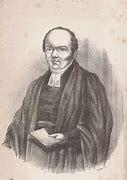
Winning the Mold Chair in 1823 brought Alun to the attention of Lord Mostyn, president of the eisteddfod, and other local dignitaries who were impressed by the young man’s evident talent. This group decided to club together to support Alun with the necessary funds to give him an education and further his ambition to become a clergyman. This support allowed Alun to gain a place at Jesus College, Oxford University and to have a classical education, learning Latin and Greek. Without funding, this train of events would have been unthinkable for a poor, working-class boy from Mold.
After graduating in 1828, he became a curate in Holywell, and became known as “the poor man’s parson” for the support he gave to those in poverty, especially during the cholera epidemic of 1832. He went on to become rector of Maenordeifi in Pembrokeshire until his death in 1840.
Alun’s timeless poem: Rhywun/Someone
Alun’s lasting legacy is a lyrical poem that is still remembered today: “Rhywun” (Someone), and the fifth of its seven verses mentions the trees on Bailey Hill – ‘y Beili’.
| Rhywun |
Someone |
| Tra bo clogwyn yn Eryri Tra bo coed ar ben y Beili Tra bo dwfr yn afon Alyn Cadwaf galon bur i Rywun |
While there are cliffs in Snowdonia
While there are trees atop the Bailey While there is water in the river Alyn I’ll keep a pure heart for Someone |
In 1909, Sir Owen M Edwards, the infuential Oxford University historian who was the first chief inspector of schools to be appointed in Wales, stated: “Eos Cymru oedd Alun, yn felus a dwys yr erys ei nodau yng nghlust ei genedl” (Alun was the nightingale of Wales, sweet and intense remain his notes to the ear of the nation). Readers of the time would have known that another of Alun’s poems was Cathl I’r Eos, a song in praise of the nightingale. The latter, and Rhywun, have stood the test of time as they both appear in the Oxford Book of Welsh Verse (first published in 1962 and frequently reprinted thereafter).
The poem Rhywun has also been set to music and can be heard on Aled Lloyd Davies’s CD “Cyn Cau’r Drws” (Before closing the door) with the Meibion Menlli choir. (Available from Sain Records)
Dr. Aled Lloyd Davies, a leading authority on Cerdd Dant or Penillion singing, was also Chair of the Pwyllgor Gwaith (the organising committee) for both the 1991 and 2007 National Eisteddfod festivals held in Mold.
Rhywun (Maes Garmon) - YouTube The fifth verse mentions “y Beili” (the Bailey)
This ambitious local eisteddfod was organised by Cymdeithas Gymreigyddion Wyddgrug (loosely translated as the Welsh Society of Mold). It was sponsored by the local gentry including Lord Mostyn, the landed families of Gwysaney, Leeswood and Rhual, the Bishop of St Asaph, local clerics and others.
The main focus of the eisteddfod was in the town centre, but the adjudication of the winning poem for the Chair was to be held on Bailey Hill. At 4pm, the full procession of the Gorsedd, in full regalia, walked through the town then made their way to Bailey Hill. The weather was good, and the presiding bard paid a tribute to the late bard, John Blackwell (Alun). The local dignitaries were in attendance. A brass band played. The harp was played by Mr Hughes from Liverpool. Poems were read praising Bailey Hill (in Welsh) and Tower (in English) and praising the chief organiser, Cain Parry who lived at Mont Alto, the property backing onto Bailey Hill (on Cilcain Road or Pwll Glas as it is now known). The ceremony ended with everybody singing 'God save the Queen' (to Queen Victoria) in Welsh.
The winning free-metre poem
The winning Pryddest was written by Iorwerth Glan Aled (Edward Roberts). The Pryddest is a poem, not in strict metre, and the prize is Y Goron (the Crown).
The poem consisted of many verses on the history of Tower, the 15th century building on the outskirts of Mold, and the legendary deeds of Rheinallt ap Gryffydd, the C17th supporter of the Lancastrian cause, and the owner of that property.
The opening page of the booklet of 212 pages detailing the analysis and adjudication of the entries and identifying the winners and other entrants for competitions in the 1851 eisteddfod. The booklet, Y Cyfansoddiadau Buddugol (the Winning Compositions) can be seen on the Library of Congress website. The judge for the historical essay was Morris Williams (bardic name Nicander) of Jesus College, Oxford, who assisted with revising of the Book of Common Prayer into a bilingual Welsh/English version (embed a link to the above and below in Library of Congress)
The winner of the essay competition: the Voice from the Hill
The winner of another competition was the bard James Hughes Jones of Mold, for his essay on the history of Bryn y Beili (Bailey Hill). His pseudonym for entering the competition was “Llais y Bryn” (Voice of the Hill).
In his essay, the bard describes some of the remnants of fine stonework on Bailey Hill. He also references the traditional account of secret passages within Mold Castle, including a door into the upper tower area from the west, and an underground passage leading eastwards. (Some claim that this tunnel connects up to the Wylfa area of Mold. Others claim that there is no tunnel at all).
A poem commemorating Richard Wilson’s life and work
Another significant competition was held at this eisteddfod: a poetry competition to celebrate the life of Richard Wilson, the renowned landscape painter who had family connections to Mold and the local gentry, the Mostyn family.
The competition was won by John Williams of Portmadoc (bardic name Ioan Madawg), with his englynion (poems written in strict meter). He entered the competition under the pseudonym of Reynolds. These englynion were subsequently carved upon the tombstone of Richard Wilson. The grave is located in St Mary’s Church, Mold, where he is buried alongside his mother and two brothers.
The winning poem consists of two four-line poems using the strict meters (so two englynion with internal rhymes, using the Welsh rules of cynghanedd). In content, the poems suggest that Richard Wilson, from his earliest years throughout his career, exuded genius. He depicted and delineated nature with great attention to detail and his work contributed to the further development of fine art and was astounding for the current age.
In 1870, Bailey Hill had been bought by subscription from the Mostyn family for the sum of £400. The money was raised from local people and philanthropic members of the local gentry and wider community. Ownership was subsequently transferred to the Mold Local Board to administer Bailey Hill on behalf of the people of Mold. At least one member of the Board, Andrew Brereton, was a bard in the eisteddfod movement.
According to The Wrexham and Denbigh Advertiser of 28 August 1873 the eisteddfod came to Mold in 1873, because members of the Mold Local Board decided to explore the idea of hosting an eisteddfod and using Bailey Hill for ceremonial events. The idea came when, in 1871, Mold’s bards and literati met on Moel Famau and took the decision to hold an eisteddfod in Mold two years later, in 1873. This would potentially be a source of “great profit” that might subsidise the expense of Bailey Hill.
At this time, in 1871, Bailey Hill was said by the newspaper report to be in a “wild state”, with buildings in a “state of decay”, and the walls surrounding the site almost “tumbled to pieces”. Mold Local Board’s funds were “entirely expended” while much remained to be done to make Bailey Hill presentable.(From this report, we can glean that not much had been spent on Bailey Hill since its acquisition, but it was opened as a publicly owned park in 1871.)
The report goes onto state that Andrew Brererton (bardic name Andreas o Fon) and other local dignitaries decided to hold the two day eisteddfod during August with the apparent intention of a Bailey Hill “opening” being tied in to the proceedings of the eisteddfod.
Concluding our interpretation of this account, we can infer that Andrew Brereton must have believed that linking a formal event on Bailey Hill to the proclamation of the eisteddfod might give greater prestige to both. However, newspaper accounts of what actually happened in the 1873 eisteddfod make no mention of an “opening” or even a re-launch of Bailey Hill at that time. It seems this part of the plan must have been abandoned fairly early on.
Proclamation ceremony on Bailey Hill in 1872
By tradition, a proclamation ceremony needed to take place at least one year and one day before the due opening of the 1873 eisteddfod – in this case August 1872. On Monday, August 12, 1872 a big ceremony, arranged by “Mr D Owen” proclaimed the forthcoming eisteddfod. Andreas o Fon, as a respected bard, carried out the proclamation ceremony on Bailey Hill.
Mold-born Daniel Owen, the lauded Welsh language novelist, and his brother were both members of the Organising Committee for the 1873 eisteddfod which co-ordinated and directed, in advance, all the plans for the forthcoming eisteddfod. Indeed, T Ceiriog Williams believes that photographic evidence indicates that Daniel Owen was the Chair of the committee.
(embed link to Daniel Owen and Bailey Hillpage)
Planning Mr Gladstone’s guest appearance
Planning the guest list for the eisteddfod in 1873,Andrew Brereton wrote to the Prime Minister, William Ewart Gladstone, of Hawarden, “asking him to honour the eisteddfod by allowing his name to appear as president for one day” and attending the eisteddfod in person. Mr Gladstone was initially reluctant, but a deputation was sent to Hawarden, his country seat, when he was in residence, in order to persuade him to come to the eisteddfod. Eventually he replied that if the Mold eisteddfod was “acknowledged by the literati of Wales” then he would attend.
Gladstone’s attendance helped to secure success for the eisteddfod, but the scale of the enterprise had to be expanded into the equivalent of a national eisteddfod in order to justify his attendance. Other reports state that the reason the Prime Minister was reluctant to attend on the chosen day was because he was committed to being at Balmoral in Scotland to meet Queen Victoria.
On the opening day of the full eisteddfod, Tuesday August 19th, 1873, at 9.30 in the morning, the Gorsedd members lined up for the procession up the High Street from the County Hall (Neuadd y Sir) onto Bailey Hill.
The rain poured down that morning and throughout the Bailey Hill visit. The bards and dignitaries and crowds went back into town and into the eisteddfod pavilion (Y Babell) which had been set up close to the railway station. In the heavy rain, the pavilion proved to be completely waterproof and could seat 4000 people, with even more space for those who could stand. The pavilion was 153ft by 102ft by 38ft and was built by John Rhydwen Jones of Rhyl under a building contract worth £450.
Gladstone made a well-received speech in which he expressed his fervent support for the Welsh language and culture, then in due course made an exit and was whisked off to Chester to catch a train to Balmoral, Scotland for a pre-engagement to meet Queen Victoria. Welsh language newspapers noted that due to Gladstone’s status, the London newspapers such as the Times, the Daily Telegraph and the Standard, were in attendance: their reporters seemed to be somewhat bemused by Gladstone’s support for Welsh language and culture. Generally the London papers tended to simply ignore the existence of eisteddfodau.
The 1873 eisteddfod choir had over 200 voices, and included Daniel Owen, the Welsh language writer born in Mold. The conductor was Pencerdd Powys (S Allen Jones) who lived in Llanarmon yn Ial and together with his wife ran a draper’s shop in Mold.
Pencerdd Powys (S Allen Jones) from 2007 (Image: 2007 Official Programme for Eisteddfod Sir y Fflint a’r Cyffiniau) for Eisteddfod Sir y Fflint a’r Cyffiniau
The Gorsedd ceremonies at the 1873 eisteddfod were also the first where distinctive robes were worn, indicating which of the orders of the Gorsedd they belonged to. Among those entering into the orders were the musician John Curwen (of Tonic Sol Fa fame).
A profitable venture
The 1873 eisteddfod was a huge success: Revenue £2000; Prizes and expenses £600; Profit £1400
The Bank of England inflation calculator shows that in today’s money (2019) this would mean:
Revenue £219,000; Prizes and expenses £65,000; Profit £154,000
Competition Winners
The winner of the Chair in 1873 was Hwfa Mon (Reverend Rowland Williams) for his poem in strict metre, Caradog yn Rhufain (Caradog in Rome). Hwfa Mon was the winner of many other competitions for various forms of poetry (some in strict metre, and in cynghanedd) in eisteddfodau around Wales. He won the eisteddfod Chair at Caernarfon (1862), Birkenhead (1878) and the Crown at Camarthen (1867). He was also elected Archdderwydd (Archdruid/leader) of the Gorsedd of Bards from 1895 until 1905 and was considered a powerful orator.
Hwfa Mon was a very well-known figure, sufficiently recognisable to be portrayed on Ogden’s Guinea Gold photographic cigarette cards, a very popular collecting pastime of the day. Ogden’s Guinea Gold cards were published between 1894 and 1907 and portrayed an eclectic mix of the famous and the infamous: celebrities, politicians, generals, artists, and more.
The 1873 Chair, carved by Robert Edwards of Mold. (Image: People’s Collection Wales)
The 1873 Gorsedd Stone Circle
A visitor to the 1873 eisteddfod was John Curwen, the man who popularised the Tonic Sol Fa musical notation system. He describes sitting at the top of the motte, and looking down on the Gorsedd area where 12 stones were organised in a circle with a larger stone in the middle: “deuddeg o geryg mawr wedi eu trefni yn gylch crwn, gyda chareg fwy yn y canol”.
Other reports confirm that the stones were placed on the bowling green i.e. to the south of the motte rather than to the north where the 1923 stone circle is now situated. This raises many questions:
- What happened to these stones used in 1873?
- What size were they, such that they could be dropped onto the bowling green without causing damage and then lifted again?
- Were they later recycled for the 1923 Gorsedd Stone Circle?
- If they were smallerstones than the 1923 stones, are they still somewhere on site?
The birth of the idea of a national library of Wales
There is one aspect of the Mold 1873 eisteddfod that made it particularly historic. It was at this eisteddfod that a meeting took place where plans were laid, for the first time, to create a national library for Wales. This initiative - that started in Mold - came to fruition when the National Library was established by Royal Charter in 1907 with a mission to collect and preserve materials related to Wales and Welsh life.
A postscript on the connection between Bailey Hill and the nearby Gwysaney estate
Mr P B D Cooke was a member of the local landed gentry who owned Gwysaney Hall and Estate, around a mile away from Bailey Hill. He made a generous donation of £15 to the subscription effort to buy Bailey Hill in 1870.
At this time, the Gwysaney estate and its owner was in the possession of the most important 12th century book in Wales. This was the original manuscript of Liber Landavensis, the Book of Llandav, Llyfr Llandaf, a set of documents on the history of the diocese of the Cathedral Church of Llandaff, near Cardiff. In the 1940s, the book was put on deposit in the newly established National Library Wales. It was fully acquired by the National Library Wales in 1959.
It is now considered a national treasure, and preserved for the nation following around 250 years in the private ownership of the Davies-Cooke family. In the photograph, you can see the oak cover and the sculpture of Christ. The book and the sculpture are stored separately nowadays by the NLW.
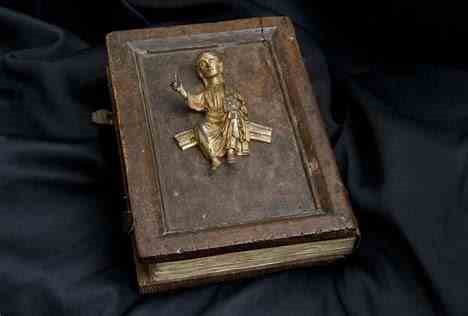
Image: National Library of Wales
Liber Landavensis, the Book of Llandav, LLyfr Llandaf,
(National Library Wales reference number NLW 17110 but was previously known as
Gwysaney MS1).
Daniel Owen (1836-1895) is often referred to as the Charles Dickens of Wales. He was a Welsh language novelist of national significance and great influence, and spent most of his life living in Mold. He would have been very familiar with Bailey Hill.
He was born in Mold to a working class family that was devastated and impoverished when his father and two brothers were killed during the local Argoed mine flood of 1837. Daniel’s mother, Mrs Sarah Owen was left with four surviving children including the baby Daniel. The family’s financial situation was so precarious that she was subsequently described as a mangle woman/pauper.
As a boy, the 14 year old Daniel was apprenticed to a Mold tailor, Angel Jones, and came under the influence of the Calvinistic Methodist Church where Jones was an elder. Working alongside other apprentices in the tailor’s shop and interacting with customers allowed Daniel to get to know the lives of the ordinary people of Mold. He drew on this material to write his novels. One novel, Y Dreflan, shares a name with the road which joins the old Cilcain Road/Pwll Glas with the Denbigh Road, close to Bailey Hill.
His book, Rhys Lewis was translated from Welsh into English and serialised with great success in England and in Scotland, but for most of his life, Daniel Owen earned his living mainly as a draper and tailor. The proceeds from Rhys Lewis, however, allowed him to buy a detached house called Cae’r Ffynnon in Maes y Dre, Mold, close to Bailey Hill.
A massive stone boulder marks the site of his family home close to Bailey Hill, where the old Denbigh Road meets the new Denbigh Road, the A541.
The young Daniel on Bailey Hill
While standing anywhere on Bailey Hill, imagine the young Daniel Owen and his friends, who would have regularly visited and played on Bailey Hill as part of everyday life. Now imagine an event where a child gathers together a group of his young friends and marches them up to Bailey Hill. He organises the children into a choir, and leads this choir in an impromptu choir service while also singing himself. This child then gives a sermon and leads a service of hymns that would be well-known to the sons and daughters of the Welsh-speaking non-conformist tradition. These events actually happened, and the child in charge was Daniel Owen. Clearly he was destined to stand out from his peers from an early age.
Daniel as Chair of the Pwyllgor Gwaith (Organising Committee)
Although Daniel Owen was not a keen competitor in eisteddfodau, he was involved with the 1873 eisteddfod in a different capacity. In 1872, the Chester Chronicle reports that “Mr D Owen”, probably Daniel, had prepared for the proclamation of the 1873 eisteddfod from plans laid down by the Reverend T R Lloyd of Llanfynydd.Together with his brother Dafydd, he was a member of the Pwyllgor Gwaith, the Organising Committee for the whole eisteddfod. This committee would need to start its work more than a year before the event.
Dr Aled Lloyd Davies- the Cerdd Dant master; former Head Teacher of Ysgol Maes Garmon, Mold; and Chair of the Organising Committee for the 1991 eisteddfod – wrote the “Cyflwynair” (Introduction) in the Official Eisteddfod Bro Delyn Programme. As he writes, he describes the old photograph he has in front of him: of Daniel and his brother Dafydd, who were both members of the Organising Committee of 1873.
Further evidence of Daniel Owen’s role in the 1873 eisteddfod is provided in Yr Hen Ddaniel, T Ceiriog Williams’s account of Daniel Owen’s life. In his book, Williams recounts the story of how he was given two photographs of Daniel Owen by the Dykins family, whose relatives had worked alongside Daniel. One photograph is of Daniel with six colleagues. This photo can be seen in the Williams book (p18), but is also in T W Pritchard’s book “Mold Town and Country” of 2012. Daniel Owen is the person sitting first left on the back row.
The second photograph that T Ceiriog Williams describes shows members of the Pwyllgor Gwaith (Organising Committee) for the 1873 eisteddfod. Williams notes that Daniel Owen sits in the front row, in the centre seat. This clearly infers that Daniel was the Chair of the Committee: “Gan fod Daniel Owen ar ganol y rhes flaen, yn y lle anrhydedd, teg yw dyfalu mai ef oedd Cadeirydd y Pwyllgor Gwaith” (p19).
A portrait of T Ceiriog Williams can be seen in Mold Library. The information panel alongside the painting notes that he gathered and preserved artefacts and ephemera relating to Owen’s life, as well as writing about his life. T Ceiriog Williams was a former Head Teacher at Ysgol Daniel Owen in Mold before it was subsumed into Ysgol Alun.
There is another group photo from the 1873 eisteddfod, shown below, and reproduced in the Official Programme for the 2007 eisteddfod. It is not clear whether this is the Pwyllgor Gwaith, or whether it is a different photograph to the T Ceiriog Williams one described above.


Is this Daniel (standing middle/bottom right on the original photo)?
Daniel Owen in the 1873 eisteddfod choir
The 1873 eisteddfod choir had over 200 voices, and included Daniel Owen. In the run-up to the eisteddfod, the choir practiced on a regular basis in readiness for their part in the concert to be held during eisteddfod week. The Wrexham and Denbigh advertiser of March 22, 1873 has an account of the choir’s activities in the form of a witty speech written and delivered by Daniel Owen.
The conductor of the choir was Pencerdd Powys (S Allen Jones) of Llanarmon yn Ial, who ran a draper’s business at The Cross in Mold, and also later on in the High Street. There is a photograph of the choir with the Bailey Hill motte as the backdrop. There appears to be a man-made step at the base of the photo, so presumably this photo was taken from the bowling-green. This south face of the motte was clear of saplings and bushes at that time.

The Gorsedd is formed by a selected group of Welsh-speaking poets, writers, artists, musicians, scientists and people of note. These are all people who have made a significant contribution to Wales and its culture. Experienced members are nominated to hold formal roles such as Archdderwydd (Archdruid). Ceremonial robes of different colours are worn by the participants, and pageantry, music and dancing come together to create a colourful ceremony.
Robe colours
A symbol often seen in connection with the eisteddfod is the Mystic Mark or the Mark of the Ray of Light (Y Nod Cyfrin; Y Nod Pelydr Goleuni) shown in this format /|\
According to the National Museum of Wales, the symbol of the Mark of the Ray of Light was first seen on the Proclamation Scroll in Cardiff, 1833. By 1850 it could be seen on the banner in Gorseddau and from around 1860 on new members' certificates. By the end of the century it was considered the approved symbol of the Gorsedd of the Bards and appeared on its programmes, on the new banner, and sometimes even described by the placing of the Gorsedd Stones.
The Corn Hirlas (Long blue horn, the “Horn of Plenty”), a symbolic item within Gorsedd cerermonies, was designed and made by the sculptor W Goscombe John for Lord Tredegar, who wished to present it to the Archdruid Hwfa Môn in Cardiff in 1899. The Horn has subsequently been used regularly for ceremonial purposes at the National Eisteddfod.
Sir Hubert von Herkomer, the well-known painter, film-director and composer designed the Great Sword used for Gorsedd ceremonies
Towards the end of the 19th century, in order to inform future Gorseddau, the Herald Bard of the eisteddfod (T H Thomas, a professional artist whose bardic name was Arlunydd Pen-y-garn) made a detailed plan of the Gorsedd Stone Circle, as a template to be followed in future eisteddfodau. T H Thomas’s aim was to standardise the Gorsedd’s formal ceremonies in order to confer more dignity and order into the way that the ceremony was planned and performed.
Arlunydd Pen y Garn (Thomas Henry Thomas)
According to this new plan, the stone placed closest to the east, the Maen Cyfamod, and the two Portal stones formed the shape of the Ray of Light. Even after the standardisation of the Gorsedd circle layout, however, the format of the Gorsedd stones still seems to have varied from one eisteddfod to another. For instance the 1904 eisteddfod in Rhyl had both an inner circle of 12 stone plus an outer circle of 17 stones.
During the 1950s it was decided that the Ray of Light symbol would be included on every national Chair and Crown (see the images of the 1873, 1991 and 2007 Mold eisteddfod Chairs, where the symbol is evident).
As with the 1873 eisteddfod, detailed planning for the eisteddfod of 1923 had to start a year before.At the time, it was customary to erect a stone circle to host the main ceremonies of the Gorsedd. But by 1922, Bailey Hill was already being viewed as a protected ancient monument and some believed that the process of building a Gorsedd stone circle within its structure might lead to some damage. The ground at the base of the motte at the north end of the site would need more levelling to accommodate the stones and to facilitate the important ceremonies of the Gorsedd. This proved to be controversial.
The counter argument for levelling the site was that Bailey Hill was already a highly compromised site due to the damage already done through shifting masses of soil to create the bowling green in the 19th century. Also, much soil and sand extraction had taken place during the Mostyn years of the 19th century. Indeed, at one point, even after the purchase of Bailey Hill by public subscription, there were those who believed it would be better to use the site for soil and sand extraction.
The final decision was to go ahead with building the Gorsedd stone circle on Bailey Hill. The Eisteddfod committee believed that any damage was minor, but required some alteration to the level of the ditch at the base of the motte. The Ancient Monuments Board of Wales took a very dim view of the whole business.
When challenged on their actions – after the eisteddfod had taken place - on Dec 11, 1923, a member of the Eisteddfod committee, Edward Davies, Vicar of Mold, wrote a letter:
“As far as I can judge all that was done was to make a level portion in order to erect the Bardic Stones.This meant levelling up (if I remember rightly) a small portion in the neighbourhood of the path that was there and the removal of a tree.When this was done the stones were put up and grass sewn there.It does not appear to me that the character of the place has been damaged nor any feature thereof destroyed.”
The officer of the Department of Ancient Monuments and Historic Buildings immediately replied on Dec 13, that:
“the damage consisted in the filling in of a portion of the ditch about 30 feet as far as I remember at the foot of the earthen mound which was originally scarped out of a natural mound in order to carry the great tower of the castle.The material for filling the ditch was obtained by levelling down an untouched portion of the original hill and the final result is that the castle has been given a new “bailey” which formed no part of its original plan.”
On Jan 8, 1924, R Stewart Kelly, a solicitor and Clerk of the Urban District Council of Mold closed down the argument by writing to the Ancient Monuments Board of Wales. He asserted that at the time of the levelling, in 1922, the Hill had not been scheduled under the provisions of the Ancient Monument Consolidation and Amendments Act 1913 as a monument of national importance. Therefore, “the council are not disposed to take any steps to restore the defences to which you refer to their previous state”. That appeared to end the discussion, and the 1923 Gorsedd stone circle and soil levels stayed where they were.
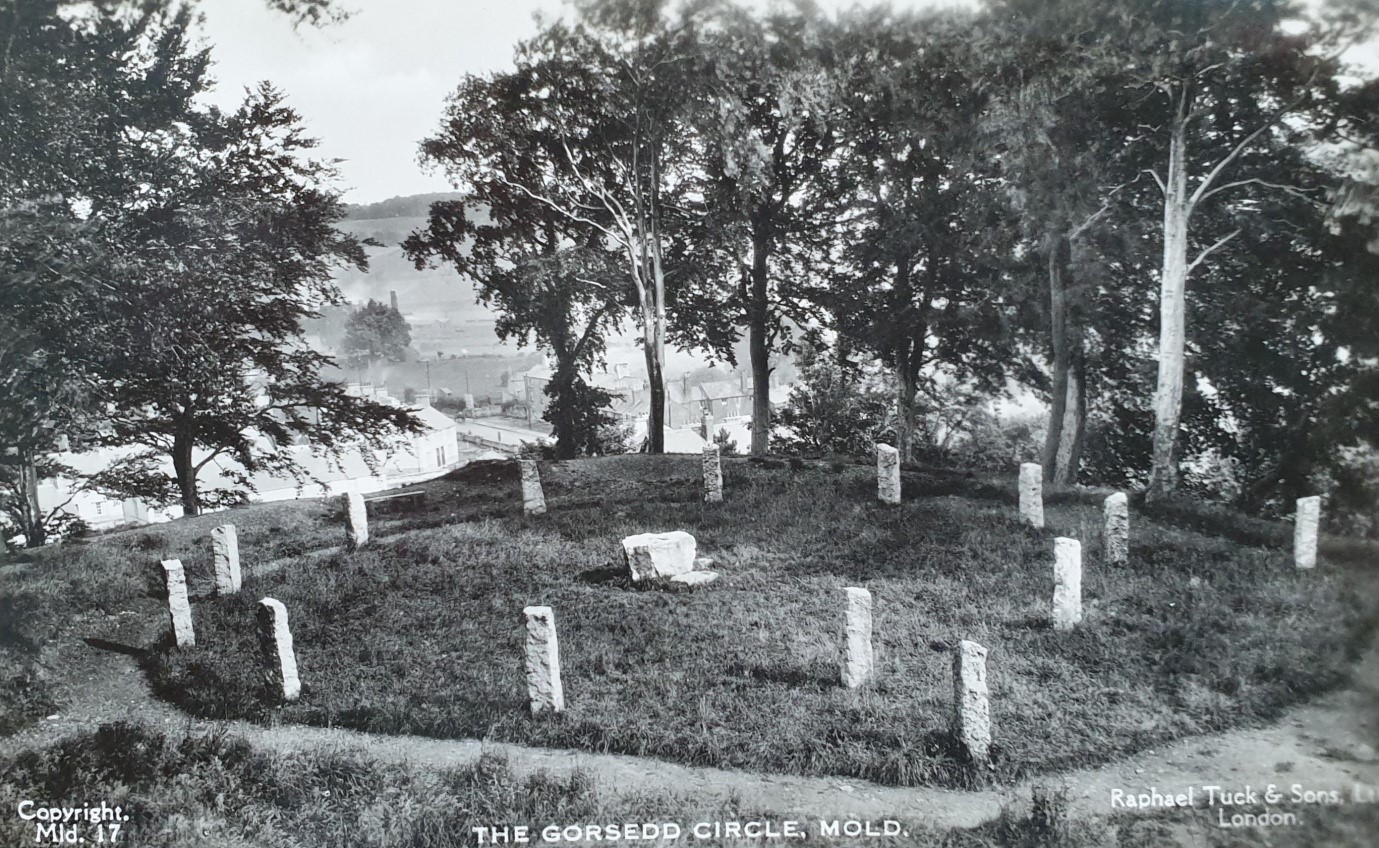
Image: from an original old postcard
In Bailey Hill’s Gorsedd Circle for 1923, there is a central Maen Llog (Logan Stone) with a circle of 12 stones around it. There are also two portal stones (situated first right and fifth right on the photo above). The portal stones flank the stones situated second right, and seventh right, within the circle, and they also flank the entrance, from the east, into the Gorsedd circle.
Archdruid John Cadvan Davies “Cadfan”, in full regalia, facing to the east on Bailey Hill
Image: from an original magazine, undated
The stone that sits equidistant from these flanks (third from the right in the photo) is the most easterly in the main circle, the Maen Cyfamod. It is traditional for the Archdderwydd (Archdruid) to be standing on the Maen Llog, facing east, when he - always a “he” until the later part of the 20th century – discharges his ceremonial duties.
Interestingly, newspaper reports of the early 20th century often described the stones used for the national eisteddfodau in great detail. With a new site being used each year, the source of the stones and who had paid for them was newsworthy.For instance, the stones for the Rhyl eisteddfod of 1904 included pink limestone from the Vale of Clwyd, millstone grit from Gwespyr quarry, aiguilles of slate from Ffestiniog and very dark Halkyn limestone. However, with regard to the Mold eisteddfod of 1923, and the Bailey Hill Gorsedd Stone Circle, there is no mention in the newspapers of the origin of the stones in the run-up to the eisteddfod.
We know that in 1873, Gorsedd stones were placed on the bowling-green, in a circle of twelve, with a larger stone in the centre. But what happened to these stones? The lack of popular newspaper coverage when the Gorsedd Stone Circle was built in 1922 might suggest that the 1923 stones were not “new” to Bailey Hill and therefore not “news”. Perhaps they were already on site since the 1873 eisteddfod and had simply been reused in a more permanent position for 1923.
Whatever the explanation, over time the Gorsedd stones, that were initially controversial, have become a much loved feature of the Bailey Hill site.
Bailey Hill and its Gorsedd Circle offer us the opportunity to find out more about the history of people who have had a significant connection to the eisteddfodau in Mold. There are stories to be told about people who were born in the Mold area who were active in the eisteddfod movement; or people who achieved success in competition at an eisteddfod in Mold; or people who simply found themselves on Bailey Hill as part of an eisteddfod ceremony.
Many of the people who had a connection to the eisteddfod, and to Bailey Hill - either in organising or competing or visiting - had interesting lives and made significant contributions to wider Welsh social and cultural life.
(embed links to the 1823, 1851, 1873, 1923, 1991, and 2007 eisteddfodau here)
Bailey Hill has provided a recurring theme for poetry in the 1823 and 1851 eisteddfodau, while Gorsedd stones have played a significant cultural or ceremonial role within eisteddfodau held in 1873, 1923, and 1991:
- One of the main prizes for the 1823 eisteddfod was won by John Blackwell, the Mold-born man who went on to write the well-known poem “Rhywun” (Someone) which directly references Bailey Hill
- In 1851, the winner was the bard James Hughes Jones of Mold, with his essay on the history of Bryn y Beili, Bailey Hill. His pseudonym for entering the competition was “Llais y Bryn” (Voice of the hill) and offers some insights into the physical features of Bailey Hill at that time. James Hughes Jones also contributed to the public subscription to buy Bailey Hill in 1870.
- In the 1873 eisteddfod, each day started with a procession by the Gorsedd from the High Street to Bailey Hill. Once the Gorsedd had made its way back down to the main pavilion, which was under cover, the full proceedings of the eisteddfod could start. In 1873, the Gorsedd stones were placed on the bowling-green and ceremonies took place there. There is an eyewitness report by John Curwen (the man who popularised the Tonic Sol Fa musical notation system), describing the scene from where he is sitting, at the top of the motte, looking down on the Gorsedd circle of 12 stones and a larger central stone
- The Gorsedd stone circle (as it looks now) was built for the 1923 eisteddfod. Some of the main eisteddfod ceremonies were held on Bailey Hill, as can be seen in the British Pathe newsreel. (embed Youtube link) The former Prime Minister David Lloyd George, a Welshman from Llanystumdwy, was the important guest for the chairing ceremony
- The 1991 eisteddfod used Bailey Hill for its proclamation ceremony and also as a place for a formal morning ceremony to kick off the events of the day
- The 2007 eisteddfod was located on the Pentrehobyn estate, some way away from Bailey Hill on the south western outskirts of Mold. By this time, the National Eisteddfod had acquired its own lightweight portable “stones” to form a Gorsedd circle wherever the eisteddfod went, whether in north or south Wales
In 1922, the 1923 eisteddfod was proclaimed on Bailey Hill, at the Gorsedd Circle. Proclamation takes place at least one year and one day before the actual event.
An opening ceremony was also held in 1923 on Bailey Hill with David Lloyd George, a Welshman from Llanystumdwy and a recent former Prime Minister of the UK also attending. There is a British Pathe newsreel which shows a procession through Bailey Hill, and a formal ceremony taking place in the Gorsedd stone circle to a packed crowd.
www.youtube.com/watch?v=8kzUGAWbm7E
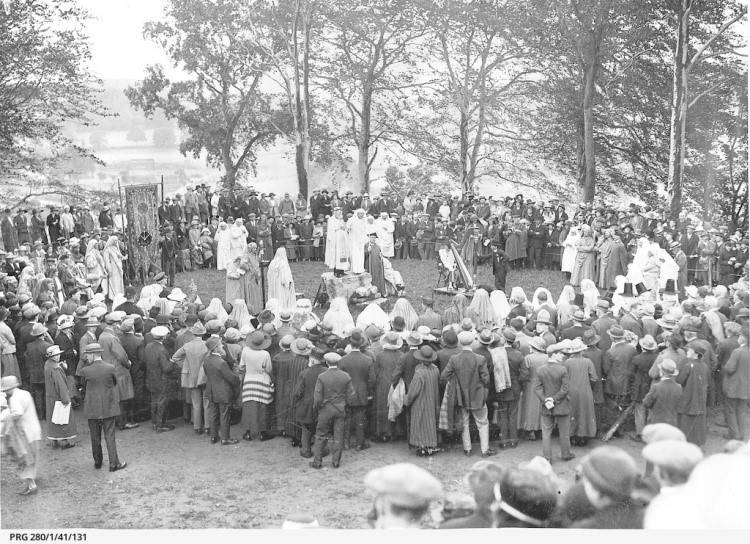
The ceremony was led by the Archdruid, Cadfan (John Cadvan Davies). Cadfan himself had local connections to Mold, having married Mary Ada Evans of Leeswood in the Wesleyan Chapel of Mold.
The eisteddfod attracted 81 choirs to compete for a variety of prizes. There were 32 choirs from South Wales alone, and others came from across the UK as well as one America choir from Cleveland, Ohio. The main pavilion for the 1923 eisteddfod was built on the Rec (Recreation Ground) in Mold and seated 11000 people.
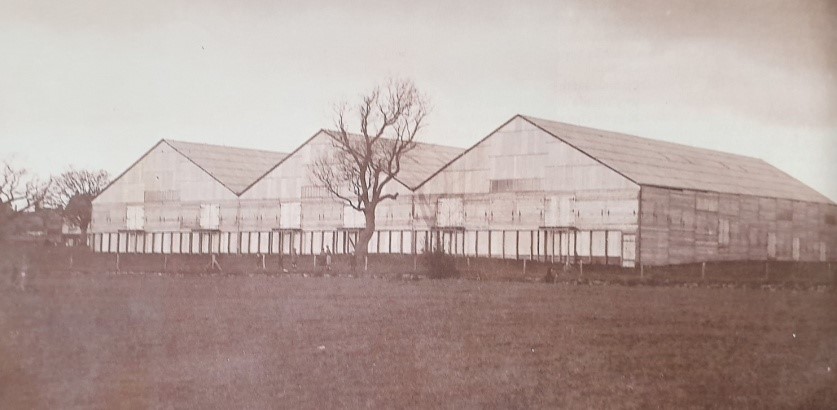
The pavilion on the Rec in Mold, 1923 (Image: (Image: 2007 Official Programme for Eisteddfod Sir y Fflint a’r Cyffiniau) 2007 Eisteddfod/ Rhaglen)
The sculptor W Goscombe John and his many connections with Mold and the eisteddfod
As part of the celebration for the 1923 National Eisteddfod, a procession of Gorsedd members and important guests made its way around Mold to honour three eminent men associated with Mold. Wreaths were placed on the gravestones of the poet John Blackwell (Alun); the landscape painter, Richard Wilson; and the novelist, Daniel Owen. The chief wreath bearers were the leaders of the Arts and Crafts section of the eisteddfod programme, namely the artist Carey Morris, the famous sculptor W Goscombe John (the tall man at the centre of the photograph below), and Isaac Williams of the National Museum.
Goscombe John was the sculptor of the statue of Daniel Owen that now stands in Mold Town Centre, in Daniel Owen Square. The Corn Hirlas (Horn of Plenty) used in Gorsedd ceremonies was also designed by him.
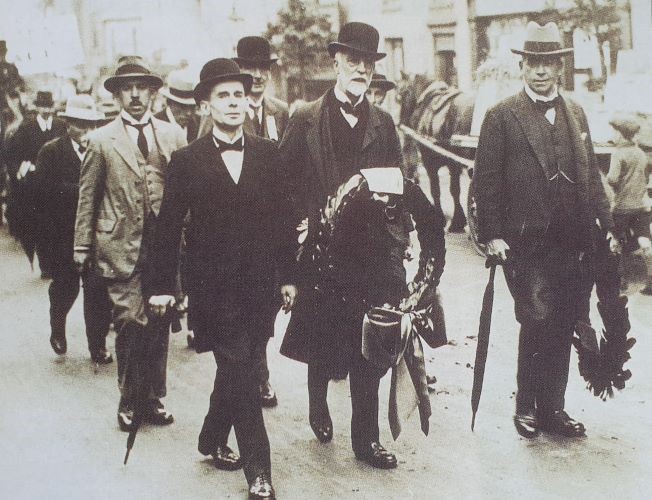
The winner of the Chair
The winner of the Chair in 1923 was Cledlyn (David Rees Davies) for his winning poem of that year, “Dychweliad Arthur” (The Return of Arthur). He was a schoolmaster, writer and poet and a master of the cynghanedd, the strict metre in which his winning poem was written.
Early success for Cynan winning the Crown
The winner of the Crown in 1923 was Cynan (Albert Evans-Jones). This was an early success for someone who was to become very influential in the shaping of Welsh culture in later years. Cynan was elected Archdruid for the period from 1950 to 1953, then again from 1963 to 1966, the only person to be appointed twice to this post. Over the years, he was also Gorsedd Recorder and joint-secretary of the Council. In these roles, he initiated organisational changes so that the Gorsedd and the Council of the Eisteddfod were one national body and equal partners in managing the National Eisteddfod. He was also the person who established the “Welsh principle” in 1959. This made Welsh the only language to be used for official proceedings, ceremonies and competitions.
Cynan was an author, dramatist and playwright, a supporter of theatre and drama in Wales, and a writer and producer of large-scale pageants at Conwy Castle and Caernarfon Castle. He used his talent to create more colourful and dramatic eisteddfod ceremonies. These innovations in the design and organisation made Cynan an important modernising figure for the National Eisteddfod, enabling people to celebrate Welsh culture in a more modern way. His adjustments helped to keep the eisteddfod relevant to its time, and to keep the Welsh language centre stage. Many believe that Cynan made the Gorsedd one of the main attractions of the National Eisteddfod and therefore enhanced this exhibition of national pageantry.Of course, every cultural event must move with the times, and no doubt there will be further changes in the future.
Cynan is still remembered by his bardic name, such has been his fame and influence in Wales. He was knighted in 1969 for his services to Welsh culture. It seems fitting, then, that Cynan’s talent was recognised early on - at Mold, and on Bailey Hill.
Charles Tunnicliffe’s portrait of Cynan (Sir Albert Evans Jones) (Image: Amgueddfa Cymru; National Museum of Wales}
Charles F Tunnicliffe, the celebrated bird and wildlife painter, who lived in Malltraeth, Anglesey for many years, painted a portrait of Cynan in 1953 in his archdruid’s robes. Oriel Mon in Menai Bridge, Anglesey, holds a permanent display of Tunnicliffe’s work.
Another winning entry was created by William Edward Williams (Gwilym Rhug) for his comedic one-act play, Llwynogod (Foxes). Gwilym Rhug was also Ysgrifennwr Ariannol (Financial Secretary) to the Gorsedd.
Following the 1923 eisteddfod, a long gap ensued before it
returned to Mold. The National Eisteddfod did however visit north east Wales
regularly during this time: Wrexham
(1930), Denbigh (1939), Rhosllanerchrugog (1945 & 1961), Flint (1969),
Ruthin (1973) and Wrexham again (1977).
This eisteddfod was named Bro Delyn, but was held in Mold. The main site was off Gwernaffield Road and Maes Garmon Road, on the north-western edge of Mold, on fields just half a mile or so north of Bailey Hill. The proximity of the two sites was useful, and some of the eisteddfod’s ceremonies took place on Bailey Hill.For example, the Gorsedd of Bards met in full regalia for a Morning Ceremony centred on the Gorsedd Stone Circle on Bailey Hill.
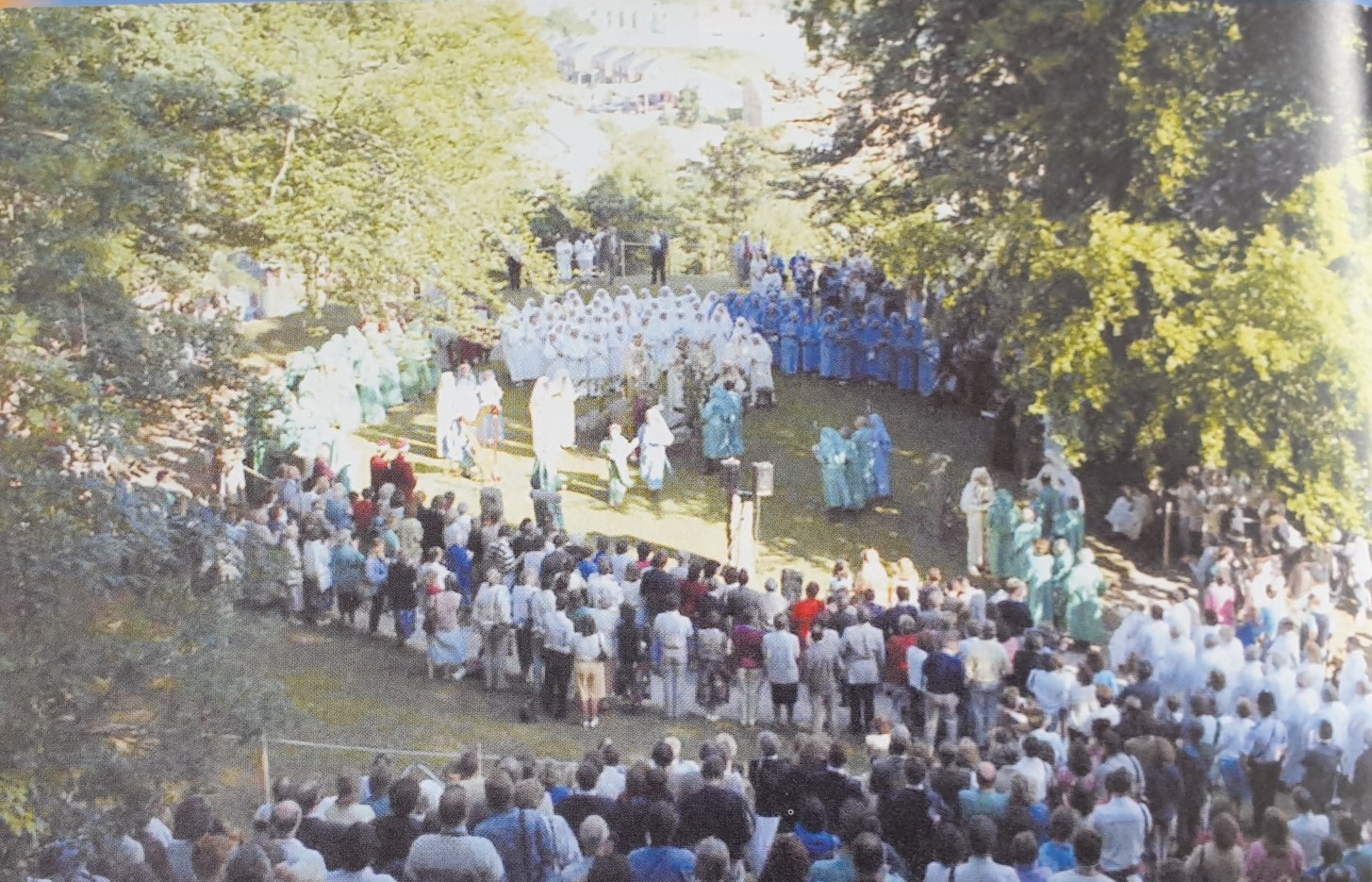
A colour photograph of that 1991 scene on Bailey Hill is shown in the Programme for the 2007 National Eisteddfod (on page 208).
The Chair of the Organising Committee (Pwyllgor Gwaith) was Dr Aled Lloyd Davies, the modern day expert on the musical art of Cerdd Dant (or Canu Penillion, which literally means singing verses). He is also a former headteacher at Ysgol Maes Garmon in Mold. In his foreword to the eisteddfod’s Rhestr Testunau (Programme of Events) he noted that amongst his predecessors on an eisteddfod Organising Committee had been Daniel Owen and his brother in 1872/73.
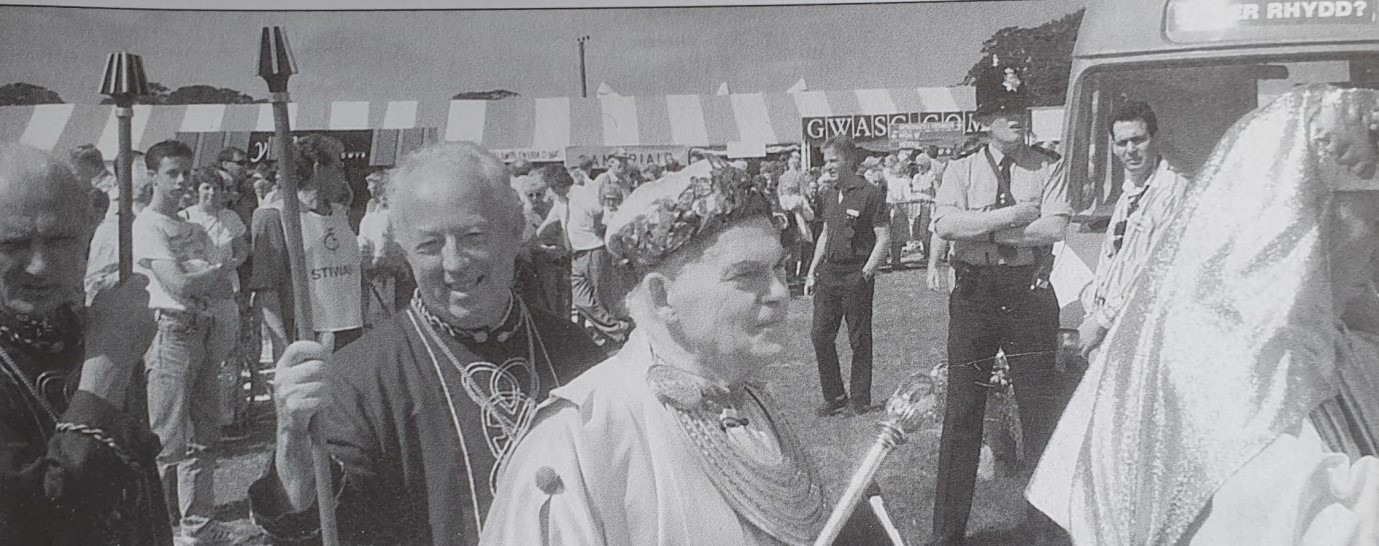
Dr Aled Lloyd Davies at the centre of the photograph, facing the camera. In front of him is the Archdderwydd (Archdruid) W R P George, nephew of David Lloyd George. Taken at the 1991 National Eisteddfod. (Image: BBC online)
Competition Winners
The winner of the eisteddfod Crown for 1991 was Einir Jones, a teacher, poet, an adaptor of children’s books, and a National Eisteddfod judge for the prestigious Crown competition in 2016. Her winning poem was on the theme of “Pelydrau” (Rays), the theme chiming with the eisteddfod’s Ray of Light symbolism.
(Image: 2007 Official Programme for Eisteddfod Sir y Fflint a’r Cyffiniau)
The winner of the Chair in 1991 was Robin Llwyd ab Owain for his work “Merch ein hamserau” (Girl of our times), a poem described by the competition judges as breaking new ground. He became the first Welsh writer to publish his poems online with his work “Rhedeg ar wydr” (Running on Glass).Note the symbolic three lines of the Mark of the Ray of Light (Y Nod Pelydr Goleuni) carved into the top of the Chair.
Robin’s songs have been sung by international opera singers Sir Bryn Terfel, and Rhys Meirion, both born in North Wales and both, in their youth, past winners of singing competitions at the National Eisteddfod. Robin’s poems have also been read on television by the actor Rhys Ifans, who attended Ysgol Maes Garmon in Mold.
Robin Llwyd ab Owain is the son of Owain Owain, the founder of Tafod Y Ddraig (The Dragon’s Tongue) the publication which gave voice to the Welsh Language Society’s campaign to defend and boost the Welsh language from the 1960s onwards.
Angharad Tomos being detained on Tuesday
Another Welsh language activist, Angharad Tomos, was the winner of the major prize of the Prose Medal (Y Fedal Ryddiaeth). Angharad, a very successful author, describes the events of eisteddfod week in Mold, in 1991. On the Tuesday of the eisteddfod week, she was detained by the police for her disruptive work as an activist for the Welsh language. In the hours after her detention, she was unsure whether she would be released in time for the Wednesday ceremony, where she was to be acclaimed as the winner of one of the three biggest competitions in the eisteddfod. She made it!
Below, Angharad Tomos on stage as a winner on Wednesday
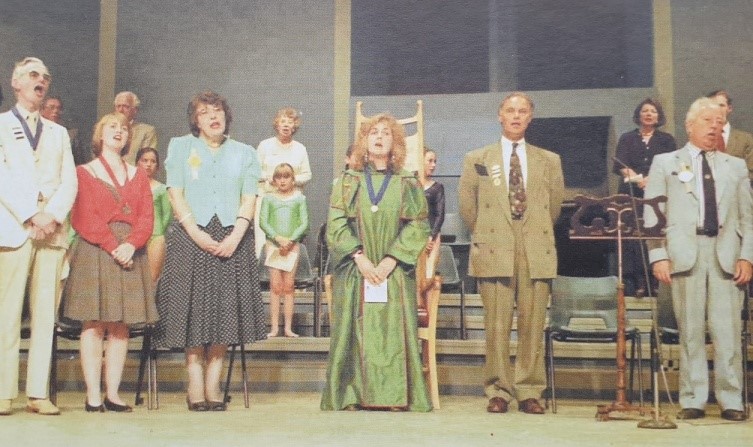
The Chairing ceremony and the song sung
During the Chairing ceremony, a specific song is sung to celebrate the success of the winning bard during the chairing ceremony. Click on the link to see and hear the sisters Eirian and Buddug yr Oernant (James), both mezzo-sopranos from Aberteifi (Cardigan), singing the chairing song at Eisteddfod Tyddewi (St David’s) 2002.
In this duet, one sister is singing low and the other is singing high. The audience join in with singing part of the verse as a chorus (Note that the winning bard is Myrddin ap Dafydd, who would go on to become Archdruid):
Can y Cadeirio Eisteddfod Genedlaethol Tyddewi 2002 - YouTube
Can y Cadeirio (The Chairing Song)
Henffych i'n prifardd ar fuddugol hynt,
Seiniwch ei enw i'r pedwar gwynt.
Hwn ydyw brenin beirdd yr Ŵyl i gyd,
Cenwch yr utgorn i bedwar ban y byd.
Henffych Brifardd! Gweiniwyd llafn y cledd,
Bloeddiodd yr Eisteddfod yn unfryd, Hedd.
Cenwch, gyd-wladwyr, heddiw'n ddiwahardd;
Cenwch wrogaeth i Gadair y Bardd.
Gorsedd dehonglwr ein breuddwydion mud
Gorsedd y Gwir yn erbyn y Byd.
Henffych Brifardd! Gweiniwyd llafn y cledd,
Bloeddiodd yr Eisteddfod yn unfryd, Hedd.
Ninnau, gymrodyr, eiliwn ein boddhad;
Calon wrth galon yw cri'r Corn Gwlad.
Llygad goleuni beunydd ar ei lwydd,
Duw a phob daioni iddo'n rhwydd.
Henffych Brifardd! Gweiniwyd llafn y cledd,
Bloeddiodd yr Eisteddfod yn unfryd, Hedd.
For a light hearted but faithful description of the different elements of the chairing ceremony at the Meifod (Welshpool) eisteddfod 2015, click here: photopol: Henffych i'n Prifardd
The 2007 National Eisteddfod was held on fields of Pentrehobyn Farm, to the south-west of Mold. However, the 1991 National Eisteddfod was to be the last where Bailey Hill played an important role, By 2007, sadly, it was deemed that the Gorsedd Circle on Bailey Hill was unsuitable on health and safety grounds. Also, the eisteddfod now had its own portable fibreglass Gorsedd “stones” with which to create the Gorsedd Stone Circle wherever it went in Wales.
However, the 2007 eisteddfod did pay homage to the role that Bailey Hill had played in past eisteddfodau in Mold. The official Programme (Rhaglen) is packed with photographs of previous Mold eisteddfodau, artefacts, buildings, and people as well as ceremonies and events taking place on the Hill in 1873, 1923, and 1991.
Also at this eisteddfod, the continuing interest in previous eisteddfodau and luminaries of Mold was evident:
- The National Library of Wales’s Rhydian Griffiths gave a lecture in the Literature Pavilion (Y Babell Lên) on the Mold Eisteddfod of 1873.
- Alun’s poem ‘Rhywun’ (which mentions Bryn y Beili/Bailey Hill) was the song set to be sung in the competition for a Solo Folk Song for the 12-16 age group (Unawd Alaw Werin, 12-16 oed).
- Hywel Teifi Edwards lectured on ‘Daniel Owen a’r Wyddgrug’ (Daniel Owen and Mold).


